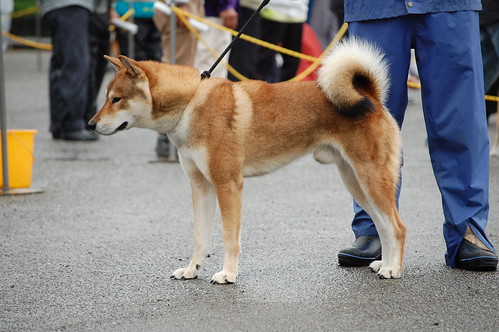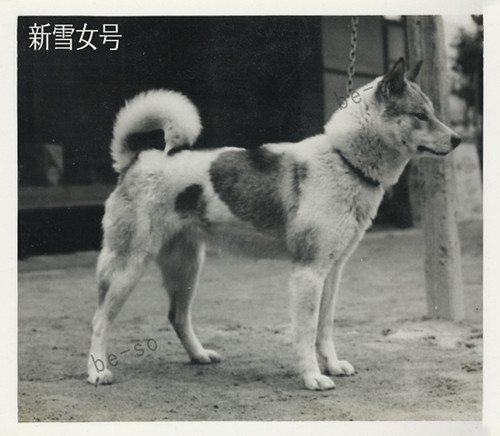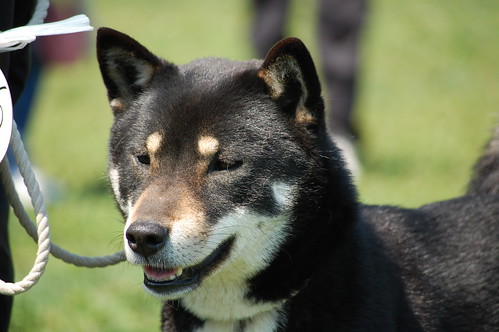Nihon Ken Coats
Having already discussed the white/cream coloration in the Nihon Ken, and the reasons why it is not very desirable, I've been thinking on, and getting feedback on the accepted colorations in the Japanese breeds.
Pulling out the standard as put forth by NIPPO we see the accepted color variations for the Nihon Ken or Japanese Dog. Here is a quick, rough translation of the original, and not an interpretation of the standard. It is written with a lot of archaic Japanese included, which always makes things a little more taxing to explain/translate.
Coat: Outer coat bristle like and straight, under coat soft and dense, hair on tail is somewhat long and stands open. Coat colors are sesame, red, yellow, black, brindle, and white.
The present day standard for the coat is slightly changed.
Coat: Outer coat bristle like and straight, under coat soft and dense, hair on tail somewhat long, with hairs open and standing. Coat colors are sesame, red, black, brindle, and white. Coat quality and color should express characteristics and features typical of the Nihon Ken.
Yellow (fawn) was removed somewhere along the line.

'... hair on tail is somewhat long and stands open .'
Looking back at old pictures of the Nihon Ken, there are some examples of piebald or spotted dogs. The fact that there this variant in coat color has always been in the breed was acknowledged in the original interpretation of the standard, but the choice to breed away from this to establish type, and preserve the other colorations was made. Small amounts of spotting was allowed on the face, chest, legs, and tip of the tail, but the preference was toward solid clean colors on the body.

Point deductions (faults): Buchige (pinto/spots/piebald)
Disqualification: Short coat due to deformity
And from the addendum, names of the the coat color variations.
Sesame: sesame 'goma', white sesame 'shiro-goma', red sesame 'aka-goma', black sesame 'kuro-goma'.
Red: red 'aka', light red 'tan-seki', crimson red 'beni-aka' .
Black: black 'kuro'
Brindle: brindle 'tora', red brindle 'aka-tora', black brindle 'kuro-tora'
White: white 'shiro'
This next part is taken from the current NIPPO judging criteria governing coats.
Permissible amounts of 'buchige' (spotting/pinto/piebald) in the large type dog (Akita)
'Buchige' is permitted, except for large spots on the trunk and extremely unsightly spotting.
Note: Large spots on the torso refers to 'botan-buchi' (peony spots). Unsightly spotting refers to 'buchige' that is not Nihon Ken in nature (e.g. Holstein like patterns).
Concerning 'urajiro' (white markings on the ventral portions of the body) in outer coat color
White fur in the following areas is considered 'urajiro', and not 'buchige'.
1. On the muzzle and cheeks of the facial area. However, the bridge of the muzzle (blaze) and reverse masks are excluded.
2. Underside of jaw, neck, chest, and belly.
3. Forechest, extending up to the shoulder joint, but not spreading over the shoulder.
4. Forelimb to elbow joint, hindlimb to knee joint.
5. Tip of the tail.
Note 1: While 'urajiro' is a distinctive feature of the Nihon Ken, guidance should still be given to prevent it from leading to an expansion of white areas in the coat.
Note 2: Points deducted for conspicuous speckling on the limbs.
Yogore-shiro (dirty white/stained white) in the outer coat
1. Yogore-shiro (dirty white) refers to faded red coloration on the ears, neck, back, top of the hip, the limbs, and the tail. This is not desirable, but is accepted.
2. Yogore-shiro that has obvious edges showing piebald patterns is not allowed.

Kishu pup showing 'yogore-shiro'.
Outer coat in the medium and small type dog
1. Coat color should be clear and sharp. Give guidance toward rich hues devoid of muddiness, and endeavor to prevent fading colors.
2. A reverse mask (white spreading from above the eye onto both cheeks, and the bridge of the muzzle) is not desirable and points will be deducted.
Coat color in the medium type dog
1. Coat color for the Kishu and Shikoku : 'goma' (sesame), 'aka' (red), 'kuro' (black aka black/tan), 'shiro' (white). However white in the Shikoku is not desirable and points will be deducted.
2. Coat color for the Kai : 'tora' (brindle).
3. Coat color for the Hokkaido : goma' (sesame), 'aka' (red), 'kuro' (black aka black/tan),'tora' (brindle), 'shiro' (white).
Coat color in the small type dog
1. 'Aka' (red), 'goma' (sesame), 'kuro' (black aka black/tan), 'shiro' (white). However white is not desirable and points will be deducted.
2. A good sesame shall be one that is a relatively even mix of black, red, and white hairs spread over the entire coat. Coats showing parts with a strong black predominance are not desirable.
3. Black should be 'tetsu-sabi-shoku' (the color of rusted iron)
Note: 'Tetsu-sabi-shoku' is jet black (coal black) and should not have a glossy sheen. It refers to a black with a touch of brown as if it has been smoked.
Black coats
1. Anything which degrades the quality of a dog's facial appearance.
2. Smudged (loss of circular shape) 'yotsume' (four eye) pattern.
3. Excessive amounts of brown on the head, neck, back, and trunk etc.
4. Coats that begin to show 'nasu-kon-shoku' (eggplant-dark-blue) or grey-black coloration as the dog ages.
The above are all undesirable traits and points will be deducted accordingly.

A 'kuro' 'yotsume' Shikoku.
So to summarize the Japanese dog's coat, and what you want to look for, or breed away from...
Look for:
Correct colors
Deep hues
-this includes brindle markings, hues should preferably be a deep 'red', grey or yellow is not desirable
-dog's with sesame coats should still have exhibit deep coloration in the coat, no blending or grey
Correct urajiro and facial markings
-watch out for white creeping over parts of the body where it should not be
-in black/tan, make sure markings are correct
Breed away from:
Washed out colors
Incorrect colors/markings
-watch for correct markings on limbs/tails as well
-coloring in coat should be even over the dogs entire body. A sesame for example should preferably not have kuro-goma over its body, and aka-goma on it's head
-breed away from black masks in all the Japanese breeds (including the Kai)
-in 'kuro' watch out for red tipping, this is a fault
Some tips and anecdotal information.
-If you are breeding Kai, and keep breeding aka-tora x aka-tora, you will see a dilution of color/brindle
-In Shikoku, if you are not careful to watch the coloration of your line, you can also quickly see a dilution of color, especially if you breed toward one coloration
-The outer guard hairs of a sesame Shikoku are 'san-shoku-himou' or three-colored-outer-hairs. Guard hairs should show 3 colors, white or light at the bottom, then red/brown, with the tips being black. These three levels of color give the coat a deep full hue.
Pulling out the standard as put forth by NIPPO we see the accepted color variations for the Nihon Ken or Japanese Dog. Here is a quick, rough translation of the original, and not an interpretation of the standard. It is written with a lot of archaic Japanese included, which always makes things a little more taxing to explain/translate.
Coat: Outer coat bristle like and straight, under coat soft and dense, hair on tail is somewhat long and stands open. Coat colors are sesame, red, yellow, black, brindle, and white.
The present day standard for the coat is slightly changed.
Coat: Outer coat bristle like and straight, under coat soft and dense, hair on tail somewhat long, with hairs open and standing. Coat colors are sesame, red, black, brindle, and white. Coat quality and color should express characteristics and features typical of the Nihon Ken.
Yellow (fawn) was removed somewhere along the line.

'... hair on tail is somewhat long and stands open .'
Looking back at old pictures of the Nihon Ken, there are some examples of piebald or spotted dogs. The fact that there this variant in coat color has always been in the breed was acknowledged in the original interpretation of the standard, but the choice to breed away from this to establish type, and preserve the other colorations was made. Small amounts of spotting was allowed on the face, chest, legs, and tip of the tail, but the preference was toward solid clean colors on the body.

Point deductions (faults): Buchige (pinto/spots/piebald)
Disqualification: Short coat due to deformity
And from the addendum, names of the the coat color variations.
Sesame: sesame 'goma', white sesame 'shiro-goma', red sesame 'aka-goma', black sesame 'kuro-goma'.
Red: red 'aka', light red 'tan-seki', crimson red 'beni-aka' .
Black: black 'kuro'
Brindle: brindle 'tora', red brindle 'aka-tora', black brindle 'kuro-tora'
White: white 'shiro'
This next part is taken from the current NIPPO judging criteria governing coats.
Permissible amounts of 'buchige' (spotting/pinto/piebald) in the large type dog (Akita)
'Buchige' is permitted, except for large spots on the trunk and extremely unsightly spotting.
Note: Large spots on the torso refers to 'botan-buchi' (peony spots). Unsightly spotting refers to 'buchige' that is not Nihon Ken in nature (e.g. Holstein like patterns).
Concerning 'urajiro' (white markings on the ventral portions of the body) in outer coat color
White fur in the following areas is considered 'urajiro', and not 'buchige'.
1. On the muzzle and cheeks of the facial area. However, the bridge of the muzzle (blaze) and reverse masks are excluded.
2. Underside of jaw, neck, chest, and belly.
3. Forechest, extending up to the shoulder joint, but not spreading over the shoulder.
4. Forelimb to elbow joint, hindlimb to knee joint.
5. Tip of the tail.
Note 1: While 'urajiro' is a distinctive feature of the Nihon Ken, guidance should still be given to prevent it from leading to an expansion of white areas in the coat.
Note 2: Points deducted for conspicuous speckling on the limbs.
Yogore-shiro (dirty white/stained white) in the outer coat
1. Yogore-shiro (dirty white) refers to faded red coloration on the ears, neck, back, top of the hip, the limbs, and the tail. This is not desirable, but is accepted.
2. Yogore-shiro that has obvious edges showing piebald patterns is not allowed.

Kishu pup showing 'yogore-shiro'.
Outer coat in the medium and small type dog
1. Coat color should be clear and sharp. Give guidance toward rich hues devoid of muddiness, and endeavor to prevent fading colors.
2. A reverse mask (white spreading from above the eye onto both cheeks, and the bridge of the muzzle) is not desirable and points will be deducted.
Coat color in the medium type dog
1. Coat color for the Kishu and Shikoku : 'goma' (sesame), 'aka' (red), 'kuro' (black aka black/tan), 'shiro' (white). However white in the Shikoku is not desirable and points will be deducted.
2. Coat color for the Kai : 'tora' (brindle).
3. Coat color for the Hokkaido : goma' (sesame), 'aka' (red), 'kuro' (black aka black/tan),'tora' (brindle), 'shiro' (white).
Coat color in the small type dog
1. 'Aka' (red), 'goma' (sesame), 'kuro' (black aka black/tan), 'shiro' (white). However white is not desirable and points will be deducted.
2. A good sesame shall be one that is a relatively even mix of black, red, and white hairs spread over the entire coat. Coats showing parts with a strong black predominance are not desirable.
3. Black should be 'tetsu-sabi-shoku' (the color of rusted iron)
Note: 'Tetsu-sabi-shoku' is jet black (coal black) and should not have a glossy sheen. It refers to a black with a touch of brown as if it has been smoked.
Black coats
1. Anything which degrades the quality of a dog's facial appearance.
2. Smudged (loss of circular shape) 'yotsume' (four eye) pattern.
3. Excessive amounts of brown on the head, neck, back, and trunk etc.
4. Coats that begin to show 'nasu-kon-shoku' (eggplant-dark-blue) or grey-black coloration as the dog ages.
The above are all undesirable traits and points will be deducted accordingly.

A 'kuro' 'yotsume' Shikoku.
So to summarize the Japanese dog's coat, and what you want to look for, or breed away from...
Look for:
Correct colors
Deep hues
-this includes brindle markings, hues should preferably be a deep 'red', grey or yellow is not desirable
-dog's with sesame coats should still have exhibit deep coloration in the coat, no blending or grey
Correct urajiro and facial markings
-watch out for white creeping over parts of the body where it should not be
-in black/tan, make sure markings are correct
Breed away from:
Washed out colors
Incorrect colors/markings
-watch for correct markings on limbs/tails as well
-coloring in coat should be even over the dogs entire body. A sesame for example should preferably not have kuro-goma over its body, and aka-goma on it's head
-breed away from black masks in all the Japanese breeds (including the Kai)
-in 'kuro' watch out for red tipping, this is a fault
Some tips and anecdotal information.
-If you are breeding Kai, and keep breeding aka-tora x aka-tora, you will see a dilution of color/brindle
-In Shikoku, if you are not careful to watch the coloration of your line, you can also quickly see a dilution of color, especially if you breed toward one coloration
-The outer guard hairs of a sesame Shikoku are 'san-shoku-himou' or three-colored-outer-hairs. Guard hairs should show 3 colors, white or light at the bottom, then red/brown, with the tips being black. These three levels of color give the coat a deep full hue.


Comments
Funny, I'm writing a blog post right now on Kai Ken brindle and color.
In Kai, regarding breeding akatora to akatora, you will also see a degrading in coat quality (thickness, length, softness).
----
Oh and Shigeru, thanks for sharing this
I ask cause I've heard a lot of random things. Brindle coats are good to breed to get coarse fur in the next generation, but that for whatever unknown reason, many brindles don't have good coats. Dunno how those two comments correlate, that is why I am asking, I'm confused. Any thoughts?
Good write up! I enjoyed reading it
I am pretty new in the world of akitas, so this is only a guess. From what I have seen of red/whites/brindles at shows their coats are pretty different. The brindle often has a longer and coarser coat than the other two colours and perhaps that is why they are good to breed coarser fur into the next generation? (I may be totally off, so hopefully someone with more experience can jump in
As for lengths I have seen no correlation between color and coat length. It more likely has to do with whether the dog is a long coat carrier, which is not color specific. However, at the shows I have been to and kennels I have visited, I have seen a tendency for reds to have longer coats than brindles/whites. I have also seen more red long coats.
On a side note, most anything that applies to brindle applies to whites, because most whites are genetically brindle and come from brindle lines. That is, if we're talking about imports from Japan or first generation dogs born in the US.